Occupational Environment Monitoring at the Waste Treatment Plant
99,000 ₫
Note: The above price is calculated for one sample, and the price may vary depending on the area of the environment to be monitored and market fluctuations. For more accurate pricing support, please refer to the quotation table or contact our consulting staff directly.
Occupational environment monitoring at a waste treatment plant is a process of collecting, analyzing, and evaluating workplace factors that may harm workers’ health.
Table of Contents
Toggle1. Overview of the waste treatment plant
a. What is a waste treatment plant?
Plant waste treatment (also known as a waste treatment factory) is a production facility designed and operated to treat various types of waste from different sources in order to reduce negative impacts on the environment and human health. The waste treatment plant is responsible for treating waste, carrying out processing, recycling, reuse, or safely and effectively disposing of waste.

b. Production stages in the waste treatment plant
The waste treatment processes in the waste treatment plant include:
- Collection: Waste is collected from various sources such as households, companies, production facilities and transported to the waste treatment plant.
- Classification and separation: Waste is classified and separated into different types such as organic waste, inorganic waste, recyclable waste, hazardous waste, and non-recyclable waste.
- Treatment and recycling: Waste is treated to separate recyclable components for reuse, such as metals, paper, plastics, glass. Treatment methods may include crushing, pressing, cutting, separating and cleaning.
- Disposal: Waste that cannot be recycled or treated will be safely and effectively disposed of through methods such as landfilling, incineration, or treatment using bacteria and biological processes.

c. Types of machinery used in the waste treatment plant
In the waste treatment plant, various types of machinery are used to carry out treatment processes. Below are some common machines used in the waste treatment plant:
- Crusher: Crushers are used to crush and break solid materials such as organic and inorganic waste into smaller forms for easier processing.
- Sieve machine: Sieve machines are used to separate materials by size or purity. They help separate recyclable materials such as metals, paper, plastics from mixed waste.
- Automatic sorter: Automatic sorting machines use sensor technology and computer systems to classify materials based on color, shape, and physical properties. This helps to separate waste types and recycle them effectively.
- Press machine: Press machines are used to compress and compact waste into bales or packages, helping reduce volume and save storage space.
- Incinerator: Waste incinerators are used to burn waste that cannot be recycled or treated. The incineration process generates heat energy and the residues are processed.
- Wastewater treatment machine: Wastewater treatment machines are used to treat wastewater generated during waste treatment. They help remove pollutants and purify water for reuse or safe discharge.
- Air compressor: Air compressors are used to create compressed air pressure to operate systems and machinery in the waste treatment plant.
- Exhaust gas treatment machine: Exhaust gas treatment machines are used to treat and clean exhaust gases generated during waste treatment, such as CO2, NH3, and other pollutants before release into the environment.

d. What occupational diseases may occur for workers in waste treatment plants?
Workers in waste treatment plants may suffer from certain occupational diseases related to environmental and work factors. Below are some common occupational diseases in this field:
- Respiratory diseases: Workers may experience respiratory problems due to exposure to dust, fumes, and toxic gases from waste. Diseases such as pneumonia, asthma, sinusitis, and breathing difficulties may occur.
- Skin diseases: Prolonged exposure to chemicals during waste treatment may cause skin irritation, dermatitis, eczema, and other skin-related issues.
- Digestive diseases: Exposure to waste and unsafe working environments may cause digestive problems such as gastritis, enteritis, and digestive disorders.
- Endocrine diseases: Toxic chemicals in the working environment may affect the endocrine system and cause issues such as endocrine disorders, impaired thyroid and adrenal gland function.
- Cancer: Prolonged exposure to carcinogens may increase the risk of cancers such as lung cancer, skin cancer, kidney cancer, and pelvic cancer.
- Nervous system diseases: Toxic substances in waste treatment may affect the nervous system and cause problems such as dementia, chronic fatigue syndrome, and neurological disorders.
- Cardiovascular diseases: The working environment may contain substances harmful to the cardiovascular system, causing problems such as hypertension, chest pain, and other cardiovascular diseases.
To prevent occupational diseases, it is necessary to implement personal protective measures, use protective equipment, comply with safe work procedures, and ensure effective operation of the waste treatment system.

e. Common waste treatment methods on the market
There are many common waste treatment methods and technologies used on the market. Below are some common types:
- Recycling: The recycling process helps reuse materials from waste such as plastics, paper, metals, and glass. Recycling helps reduce waste volume and ensures more efficient use of natural resources.
- Incineration: The incineration process burns waste at high temperatures, generating heat for electricity or fuel. This method reduces waste volume, eliminates pollutants, and generates renewable energy.
- Use of renewable energy: Waste treatment plants can also use renewable energy such as solar energy, wind energy, or energy from biogas generated by organic waste decomposition.
- Organic decomposition: Organic waste decomposition through biological or anaerobic processes helps separate organic waste and produce organic fertilizer or biomass energy.
- Landfilling: The landfill method is used when waste cannot be recycled or treated by other methods. Waste is placed in designated areas and covered with soil to prevent environmental pollution.
- Wastewater treatment: Waste treatment plants may also treat wastewater generated from waste treatment processes to remove pollutants and reuse water in production.
- Water reuse and recycling: Some waste treatment plants may process wastewater and reuse it for purposes such as irrigation, cleaning, or industry.
2. Overview of labor environment monitoring services
a. What is labor environment monitoring at waste treatment plants?
Labor environment monitoring (or labor environment measurement) at waste treatment plants is the activity of collecting, evaluating, and analyzing measurement indicators of labor environment factors at the waste treatment plant, in order to implement timely solutions, minimize environmental harm to workers’ health, and prevent occupational diseases. Labor environment monitoring is a mandatory requirement for waste treatment plants.
Labor environment monitoring plays the most important role in caring for, protecting, and improving workers’ health because the main resource of businesses and the direct creators of profit are the workers. Workers frequently exposed to risk factors and occupational hazards exceeding permissible standards will have their health affected and may develop occupational diseases.
REGISTER FOR LABOR ENVIRONMENT MONITORING SERVICE
b. Labor environment monitoring program of Nam Viet
The labor environment monitoring program of Nam Viet is a program researched by monitoring engineers in the field of occupational safety and environmental protection. With the goal of ensuring workers’ health and safety, this program uses modern measurement methods to monitor air quality, water, and microclimate, physical factors, dust, etc. in the labor environment. This is a very important program in ensuring a safe working environment and protecting workers’ health.
In addition, the labor environment monitoring program of Nam Viet also plays an important role in researching and developing new solutions to improve the quality of the labor environment. With the dedication and professionalism of its monitoring experts, Nam Viet’s exclusive monitoring program is becoming a breakthrough in the field of occupational safety management and environmental protection in Vietnam.

c. Standardization in labor environment measurement procedures
Standardization in Nam Viet’s labor environment measurement procedures is a very important aspect in ensuring the quality of measurement results. To ensure the accuracy and reliability of measurement results, this program uses recognized standards and standardized procedures of the Ho Chi Minh City Department of Health. This ensures that the collected data can be used with high reliability in assessing the labor environment and making decisions to improve it for the protection of workers’ health.
These standardized procedures also ensure that measurement results are carried out by monitoring specialists with high qualifications and years of experience, helping managers and experts rely on results from An Toan Nam Viet to make accurate and valuable decisions in protecting workers’ health and the environment.
By applying standardization in labor environment measurement procedures, Nam Viet demonstrates its commitment to ensuring a safe working environment and protecting workers’ health, while also contributing positively to the development and improvement of occupational safety management and environmental protection quality in Vietnam.
d. Monitoring report results of waste treatment plants
Labor environment monitoring results are prepared according to Form No. 04 Appendix III issued together with Decree 44/2016/ND-CP and made in 02 copies: 01 copy sent to the labor facility that signed the contract for labor environment monitoring and 01 copy kept at the organization performing the monitoring.
The storage time for labor environment monitoring results, according to law, is indefinite.

e. Frequency of labor environment monitoring as regulated by law
According to Clause 2 Article 18 of the Law on Occupational Safety and Hygiene 84/2015/QH13, employers must organize labor environment monitoring to assess harmful factors at least once a year.
f. Deadline for submitting labor environment monitoring reports as regulated by law
The deadline for report submission is before December 31 each year. Enterprises belonging to production facilities are required to submit labor environment monitoring reports to the local Department of Health where the production, business facility has its headquarters and where workers are working.
When there are changes in technology processes, production processes, or when renovating and upgrading labor facilities that may generate new harmful factors to workers’ health, enterprises belonging to production facilities must update labor hygiene records related to harmful factors that require labor environment monitoring.
g. Regulations on penalties for violations of labor environment monitoring by employers
According to Article 27 of Decree No. 12/2022/ND-CP dated 17/01/2022 regulating administrative penalties in the fields of labor, social insurance, and Vietnamese workers working abroad under contracts.
- Clause 2: A fine of 2,000,000 – 5,000,000 VND for employers who fail to publicly announce to workers at the labor environment monitoring site and at the inspected, evaluated, managed hazardous factor sites immediately after monitoring results and inspection results are available.
- Clause 3: A fine of 20,000,000 – 40,000,000 VND for employers who fail to conduct labor environment monitoring to control harm to workers’ health as prescribed by law.
- Clause 4: A fine of 40,000,000 – 60,000,000 VND for employers who collaborate with labor environment monitoring organizations to commit fraud in monitoring activities but not to the extent of criminal prosecution.
3. Harmful environmental factors for workers in waste treatment plants
Workers in waste treatment plants may encounter the following harmful environmental factors:
- Dust and fine particles: The waste treatment process often generates dust and fine particles from sorting, recycling, shredding, and transporting waste. Dust and fine particles can irritate the respiratory tract and eyes, and long-term inhalation can cause respiratory problems such as asthma, pneumonia, and other lung diseases.
- Chemicals: Waste treatment plants may use chemicals to process and handle waste. These may include cleaning agents, disinfectants, or other treatment substances. Long-term exposure to these chemicals can cause irritation of the skin, eyes, and respiratory system, and may lead to serious health issues such as hepatitis, kidney damage, and problems affecting the nervous system.
- Exhaust gases and odors: The waste treatment process often generates exhaust gases and unpleasant odors. Exhaust gases may contain pollutants such as volatile organic compounds, methane gas, toxic exhaust gases, and other contaminants. Long-term exposure to exhaust gases and odors can cause respiratory irritation, fatigue, dizziness, and other health problems.
- Poisoning from waste: Waste treatment plants may handle hazardous and dangerous wastes such as industrial chemicals, dyes, batteries, tobacco products, and medical waste. Exposure to these wastes can cause poisoning and serious health problems such as cancer, liver damage, nervous system disorders, and immune system issues.
- Noise: The waste treatment process can generate noise from machinery, equipment, and transportation activities. Continuous and high-intensity noise can cause stress, insomnia, hearing loss, and affect the overall health of workers.
REGISTER FOR OCCUPATIONAL ENVIRONMENT MONITORING SERVICE
4. Measures to improve the working environment in waste treatment plants
To improve the working environment in waste treatment plants and protect workers’ health, the following measures can be applied:
- Waste management: Ensure that wastes are treated and recycled according to safe and legal procedures. Apply appropriate treatment methods such as sorting, recycling, and safe landfilling.
- Ventilation systems: Install effective ventilation systems to remove exhaust gases and odors. Use extraction, filtration, and exhaust treatment systems to reduce impacts on workplace air quality.
- Personal protective equipment: Provide appropriate personal protective equipment for workers such as masks, protective goggles, gloves, raincoats, and safety footwear. Ensure workers are trained and use protective equipment correctly.
- Noise reduction: Use engineering measures to reduce noise, including insulating and soundproofing machinery and work processes.
- Training and supervision: Train workers on occupational safety, work procedures, and the use of protective equipment. Conduct periodic health checks and monitor relevant health indicators.
- Chemical management: Use chemicals that are safe and legal. Store, transport, and handle chemical wastes in accordance with regulations and safety guidelines.
- Sanitation and personal hygiene: Ensure sanitation and personal hygiene are well maintained. Provide adequate sanitation facilities and ensure proper handwashing and proper handling when in contact with waste.
- Monitoring and evaluation: Conduct periodic monitoring and evaluation to identify environmental and work-related health issues. Propose improvement measures based on evaluation results.
- Regularly organize occupational environment monitoring in factories and enterprises to collect and analyze harmful factors affecting workers, thereby adjusting and reducing hazards to prevent occupational diseases for them.
5. Benefits of periodic monitoring of waste treatment plants
An Toan Nam Viet provides your enterprises with excellent benefits when using occupational environment monitoring services in accordance with Decree 44/2016/ND – CP regarding the management and control of harmful factors in the working environment that affect workers.
- Your enterprise can proactively control harmful factors at workshops or factories.
- Receive consultation and recommendations on measures to minimize harmful factors and improve the quality of the working environment.
- Indirectly protect human resources, the key factor in the development process of enterprises.
- Reduce the impact of occupational diseases on human health, thereby lowering future medical treatment costs.
- Improved worker health leads to assured and maintained product quality as well as production output.
- Comply with occupational safety laws, avoiding legal risks.
- Create credibility and professionalism in all aspects, thereby elevating your enterprise’s brand.
The occupational environment monitoring service of Nam Viet is a solution that reduces the impact of occupational diseases, contributing to a fresh and high-quality working environment.

6. National occupational environment monitoring center
Occupational environment monitoring center of Nam Viet is a professional unit for monitoring and measuring the quality of the working environment throughout all provinces and cities in Vietnam. With a team of experienced monitoring specialists, the center uses modern measuring equipment to ensure accuracy and reliability.
In addition to providing monitoring services, the center also supports customers in planning, handling, and following up on occupational environment issues. With the motto “customers are the center,” the center prioritizes customer satisfaction, meets all customer needs, and is committed to offering the best solutions for enterprises.
REGISTER FOR OCCUPATIONAL ENVIRONMENT MONITORING SERVICE
With investments in engineering, technology, and human resources, the monitoring center of Nam Viet has been and is becoming one of the reputable units in the field of occupational environment monitoring in Ho Chi Minh City with the following goals:
- We always value brand reputation and the quality of our service products.
- We provide customers with the best and most suitable options possible.
- Together with a team of Masters and Engineers who have extensive experience and expertise, we aim to protect the environment and bring benefits to enterprises.
- By choosing the Occupational Environment Monitoring team of Nam Viet, your company will receive professional service from experts in the monitoring field, along with the best possible cost advantages.
The procedure for conducting occupational environment monitoring at Nam Viet includes the following basic steps:
- Before conducting occupational environment monitoring, our company always ensures that machinery and equipment used for occupational environment monitoring are adjusted and calibrated in accordance with legal regulations.
- Carry out fully and correctly the occupational environment monitoring procedure as committed to the Department of Health.
- Report the results of occupational environment monitoring honestly to employers.
- In cases where occupational environment monitoring results do not ensure safety for workers, Nam Viet will support with remedial solutions, and the workplace will implement the following:
- Implement measures to improve working conditions to minimize the influence of harmful factors and prevent occupational diseases.
- Organize health examinations to detect occupational diseases and work-related illnesses early for workers in workplaces where the working environment is not guaranteed.
- Provide in-kind allowances for workers in accordance with labor laws.

7. Quotation for occupational environment monitoring
To help enterprises conduct occupational environment monitoring in a professional and effective manner, Nam Viet provides customers with a quotation table for occupational environment monitoring services that offers quality at a reasonable cost.
- Our quotation table provides detailed information on the prices of the monitoring services we offer, including costs related to travel, measurement, analysis, and reporting of results. Customers can be completely assured of the accuracy and reliability of the monitoring reports we provide.
- We are committed to offering the most competitive and reasonable prices on the market, and we are always ready to consult and respond to all inquiries about monitoring services quickly and professionally.
- With the quotation table of Nam Viet, customers can easily select service packages that suit their needs. We are committed to delivering the highest level of customer satisfaction with professional service quality.
No comments yet

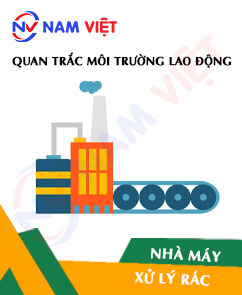
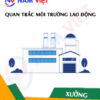

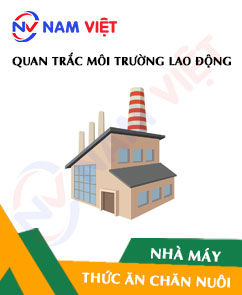
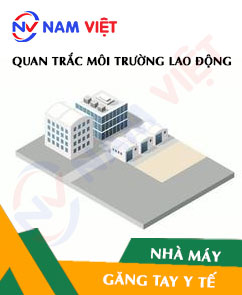


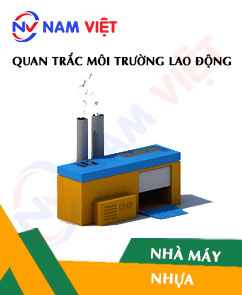



Review Occupational Environment Monitoring at the Waste Treatment Plant
There are no reviews yet.